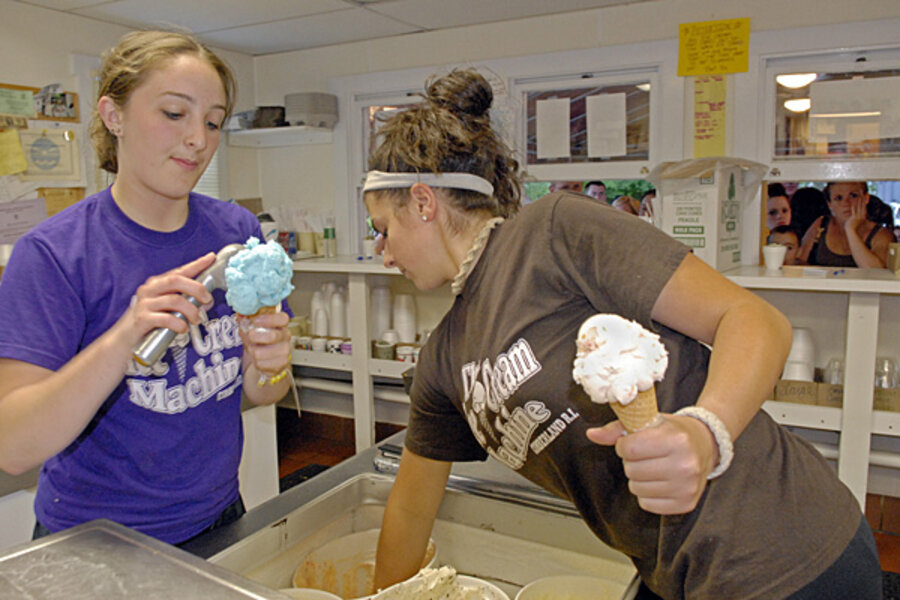Only 40 percent of teenagers work during the summer
Loading...
An American rite of passage is slowly fading into a red summer sunset.
A generation ago, nearly three of every four teenagers spent their summer vacation tending lawns, bussing tables or lifeguarding at the local pool, squirreling away cash for a car, spending money on the weekends or saving for college in the fall.
Today the employment participation rate of 16-to-19 year-olds working during the summer is down around 40 percent—part of a decades-long downward trend, according to data from the Bureau of Labor Statistics. Measured by employment-population ratio, the drop is equally pronounced: in 1989 the majority of teenagers were working in the summer, but by 2010 less than a third did.
So why aren’t American teens working anymore?
Part of the reason is the market of jobs typically tailored for teens is shrinking. Underemployment and the loss of low-skilled factory jobs has led to older workers crowding the competition for work at fast food restaurants and retail stores. The median age of fast food workers, for example, is now 29. Ten years ago teens made up a quarter of the fast-food workforce; now it’s only 16 percent.
Another reason might be that more school systems going to year-round schedules and more students opting for summer school. More than 50 percent of teenagers attended summer school in 2009. But, of course, that doesn’t mean students can’t juggle school in the day and part-time work at night—as recently as 2000, half of summer school attendees also worked jobs.
Part of the trend, says one recruiting firm, is teenagers are turning up their nose at minimum-wage jobs.
“Some teens have dropped out of the labor force due to discouragement, this group represents a tiny portion of the rising number of 16- to 19-year-olds abandoning the labor force by choice,” said a recent report from recruiting firm Challenger, Gray and Christmas. “The rising number of teenagers not wanting to work is not a post-recession trend. While the number of 16- to 19-year-olds not in the labor force who want a job has remained relatively flat since the mid-1990s, the number not wanting a job has steadily increased.”
If current trends hold, it appears that Gen Xers like myself will be the last generation for whom it is common to have a continuous line of employment from youth: My first job was as a 9-year-old toting newspapers, followed by cooking at the Ponderosa Steak House during high school and third-shift factory work in college, all the way to the 45-year-old being paid to type these words.
Indeed, the current trend was presaged by the demise of the paperboy, that once-pervasive entry to employment for many kids. In 1994, 57 percent of carriers were 18 or younger; by 2004, 81 percent of newspaper routes were handled by adults in cars, according to the Newspaper Association of America.
John Challenger, the CEO of Challenger, Gray & Christmas and author of the report on teen work, says this new generation isn’t lazy. “In fact, it is quite the opposite. They are spending more time on homework. More of them are involved in more extracurricular activities, to the extent that some parents are worried that their children are over-scheduled.” And about 4.6 million teens spend time volunteering. “All of these factors take away from time that used to be spent in a traditional job,” he said.
The increased competition to get into prestigious colleges and universities is feeding the trend. But that effort may be misplaced. As David Leonhardt recently noted in the New York Times, “there is still scant evidence that the selectivity of the college one attends matters much. Students with similar SAT scores who attended colleges of different selectivity—say, Penn and Penn State—had statistically identical incomes in later years, according to research by the economists Stacy Dale and Alan Krueger.”
What teens gain in fodder for college applications, they lose in career skills down the line. As a recent study by Drexel University notes, job experience in high school boosts future income by 20 percent to 25 percent a decade later. Other studies show former teen employees are less likely to suffer extended periods of unemployment later in life.
More than pocket money, jobs provide teens their first real foray into adult life—the first time working with adults who you don’t address as “Mr.” or “Mrs.,” the first time being thrown together with a group of people with widely different ages and socioeconomic backgrounds. And it’s the first time young adults confront real world problems, like how do you deal with an angry customer who got the wrong food order as the line at the register grows and you’re covering two stations because a colleague didn’t show up?
Fat chance summer school will teach you how to solve that problem. As teen employment declines, it’s troubling to think what else is being lost with summer jobs







